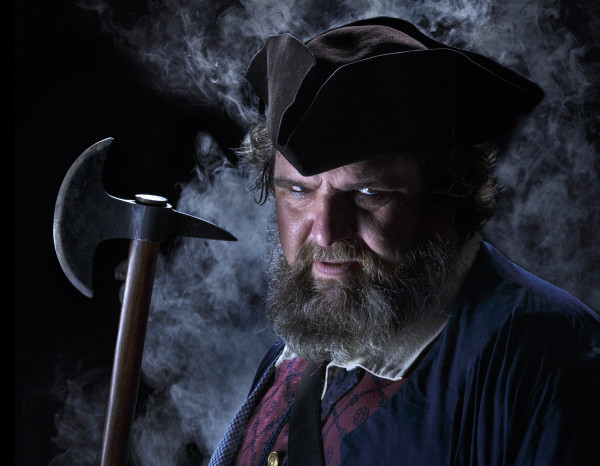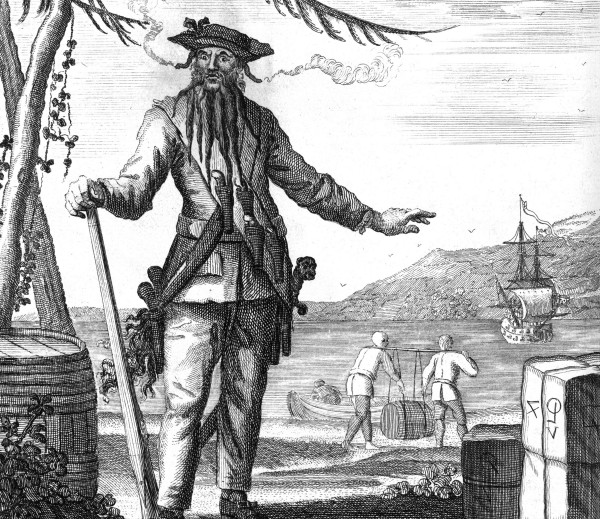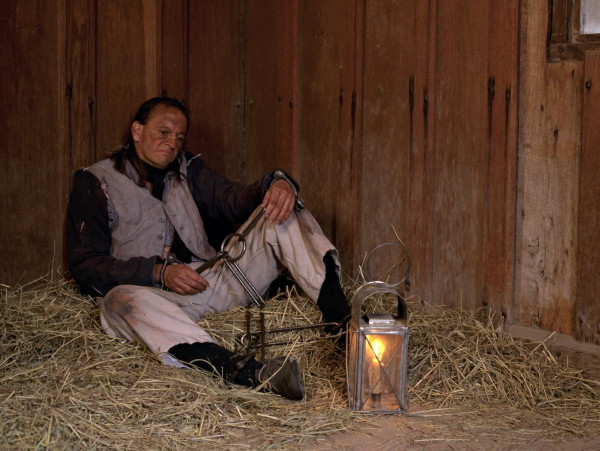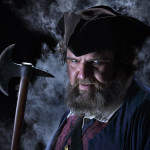
Blackbeard will be seeking his revenge when he and his crew haunt DoG Street Halloween weekend, but what did the legendary pirate really have to do with the colonial capital? And what could he possibly have against us?
Well, it just happens that the College of William & Mary and the city of Williamsburg (1699) were established right in the middle of what is commonly called the Golden Age of Piracy, which, depending on who you ask, dated from about 1680-1725. This is where our (campy) Hollywood pirates—think Johnny Depp as Jack Sparrow—come from. But for someone planning ocean travel in the early 1700s, the prospect of encountering a pirate attack was genuinely terrifying.
A 1688 pirate encounter actually helped to fund William & Mary. Capt. Simon Rowe, patrolling the James River for pirates, discovered three Englishmen and a black servant carrying a suspicious cargo on their shallop. It included silver, lace, and silk stockings. Even in a colonial outpost like Virginia, they knew pirate booty when they saw it.
The Englishmen tried to proclaim their innocence, but the servant fessed up about what they were really up to. Still, the pirates were able to take advantage of one of the king’s periodic pardons for those willing to abandon the outlaw life. After a year in Virginia (to prove they were on the straight and narrow), the men returned to England and requested the return of the treasure that had been seized from them. They succeeded in their appeal (crazy, right?), but a quarter of the total, some 300 pounds, was set aside to help build the college, which opened its doors in 1693.
The Atlantic coast from New England to the Caribbean was a highway filled with trade goods. In other words, potential booty. Virginia’s governor, Francis Nicholson was concerned enough about ongoing piracy that in 1700 he traveled to New York to meet with the governors of New York, New Jersey, and Pennsylvania to discuss it.

Blackbeard’s flag
We were promised terrifying, you say. Where’s the revenge? you ask. Arrr! We’re getting to that.
Blackbeard was as legendary as any pirate of his day. It was said that he was cruel even by pirate standards, that he was almost impossible to kill, and that he was so fierce “that imagination cannot form an idea of a fury from hell to look more frightful.”
Perhaps.
Edward Teach was his real name, and he was likely born around 1680 in Bristol, England, although he might have been born in Jamaica, where he had relatives. A life at sea was common for young men hailing from either place.
Teach took up privateering in Jamaica during the War of the Spanish Succession (1702-13), going after French and Spanish ships. Privateers carried a letter of marque that made it legal—at least in their own country—to plunder enemy shipping.
In the early modern Atlantic, the line between privateering and outright piracy was blurry, though, and many sailors spent time on both sides. Teach made the jump to piracy on a ship captained by Benjamin Hornigold sometime before 1717. The Bahamas were his first base of operations, and soon he was captain of his own ship.
His biggest score was capturing a large French Guineaman, which he renamed the Queen Anne’s Revenge, equipped with 40 cannon, and manned with a 300-person crew. Newspaper accounts of his exploits built his reputation, and there’s every sign that he purposefully fashioned an image designed to strike fear among mere mortals.
One ship’s captain victimized by Blackbeard described him as “a tall spare man with a very black beard which he wore very long.” But such ordinary descriptions, along with Blackbeard’s exploits, were rendered more colorfully in newspapers of the day, then embellished further in Charles Johnson’s successful 1724 book, “A General History of the Pyrates.” Many people continue to rely on its anecdotes even when they can’t be substantiated elsewhere.

While in North Carolina he reportedly married a 16-year old girl even though it was believed that he already had a wife, and perhaps children, back in England. It was also claimed he had wed a dozen other women, although like so many details of Blackbeard’s life, there is precious little corroborating evidence.
He carried multiple guns, which seems likely enough in an age when firearms were simply less dependable. He tied slow-burning fuses into his mass of long hair. He and his crew took what they wanted and more often than not scuttled or burned the ships they attacked, although a few were allowed to continue sailing after being raided.
Wanton killing doesn’t appear to have been his style, however.
This is most apparent with his siege of Charleston, South Carolina in May 1718. He took hostages, including a member of the Governor’s Council, and threatened to kill them if his demand for a ransom of needed medical supplies wasn’t met.
For days the ransom was not delivered. No explanation was offered.
But Blackbeard kept extending the deadline. Finally the supplies appeared, and the captives were released without harm. This stands in contrast to his bloodthirsty reputation. One repeated tale has Blackbeard maiming his sailing master, Israel Hands, without provocation. “If I did not now and then kill one of you,” Blackbeard supposedly said, “you would forget who I am.” It’s just the sort of legend that undoubtedly made it easier for the pirate to instill fear.

Israel Hands
After very briefly abandoning piracy in North Carolina, he returned to it enthusiastically within months, wreaking havoc with trade along the Carolina and Virginia coast. He may have been in cahoots with North Carolina’s Gov. Eden, or it may be that it wasn’t feasible to stop him.
In any case, the pleas of merchants prompted Virginia’s governor, Alexander Spotswood, to personally finance a mission to capture Blackbeard later that year. Two British Navy sloops under the command of Lt. Robert Maynard headed out from Kecoughtan, Va. (modern-day Hampton) on Nov. 17.
They found the pirate at Ocracoke Inlet on North Carolina’s Outer Banks. On Nov. 22, after boarding the navy sloop with his crew members, Blackbeard was killed in fierce fighting with guns and swords, ending his very brief but remarkable career.
Maynard reported that it had taken five bullets and 20 stab wounds to kill Blackbeard, which undoubtedly fed the legend that he was hard to kill. To hear Blackbeard tell the story himself, click here.

Fifteen members of Blackbeard’s crew were brought to Williamsburg to face trial. The men were tried in the Virginia capital on March 19, 1719. The trial records are lost, but we know that one man, Samuel Odell, was found not guilty. He successfully claimed he had been forced into piracy.
14 were condemned to die by hanging. Indeed, 13 of them likely twisted on the hangman’s noose at a site on Capitol Landing Rd., not far from the Public Gaol where they had been held.
One condemned man survived. Israel Hands, the ship’s master, was allowed to claim a king’s pardon that arrived just in time to spare him his own trip to the gallows. It’s unclear why he didn’t face execution at the same time as his fellows. Might he have turned against them?
An oft-told tale claims that Maynard left Blackbeard’s severed head hanging from the bowsprit, and that the head dangled from a pole at a place called Blackbeard’s Point in modern Hampton, Va. Another legend has it that Blackbeard’s skull was turned into a large cup, or a punch bowl, in Williamsburg. It hasn’t turned up…. yet.


Leave a Reply